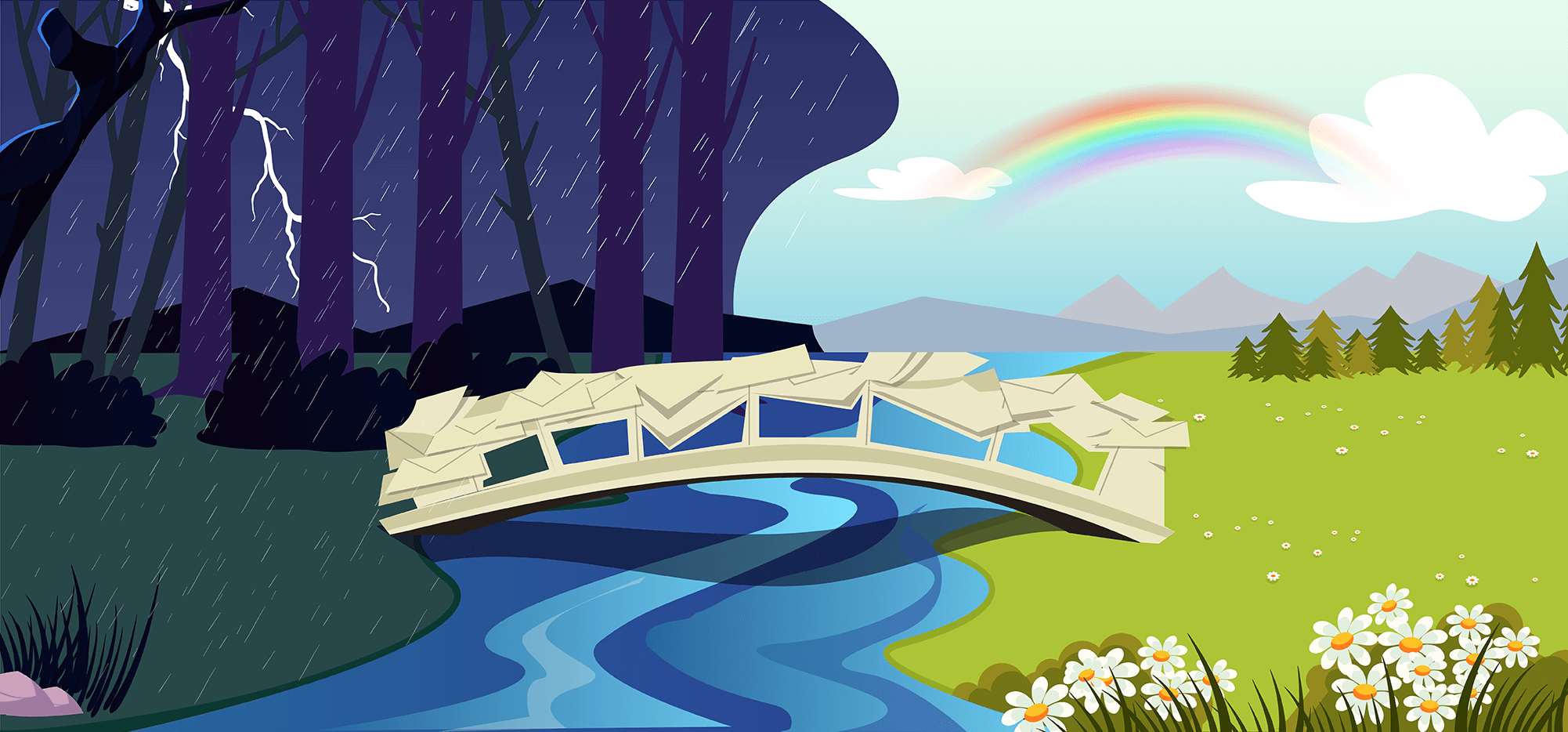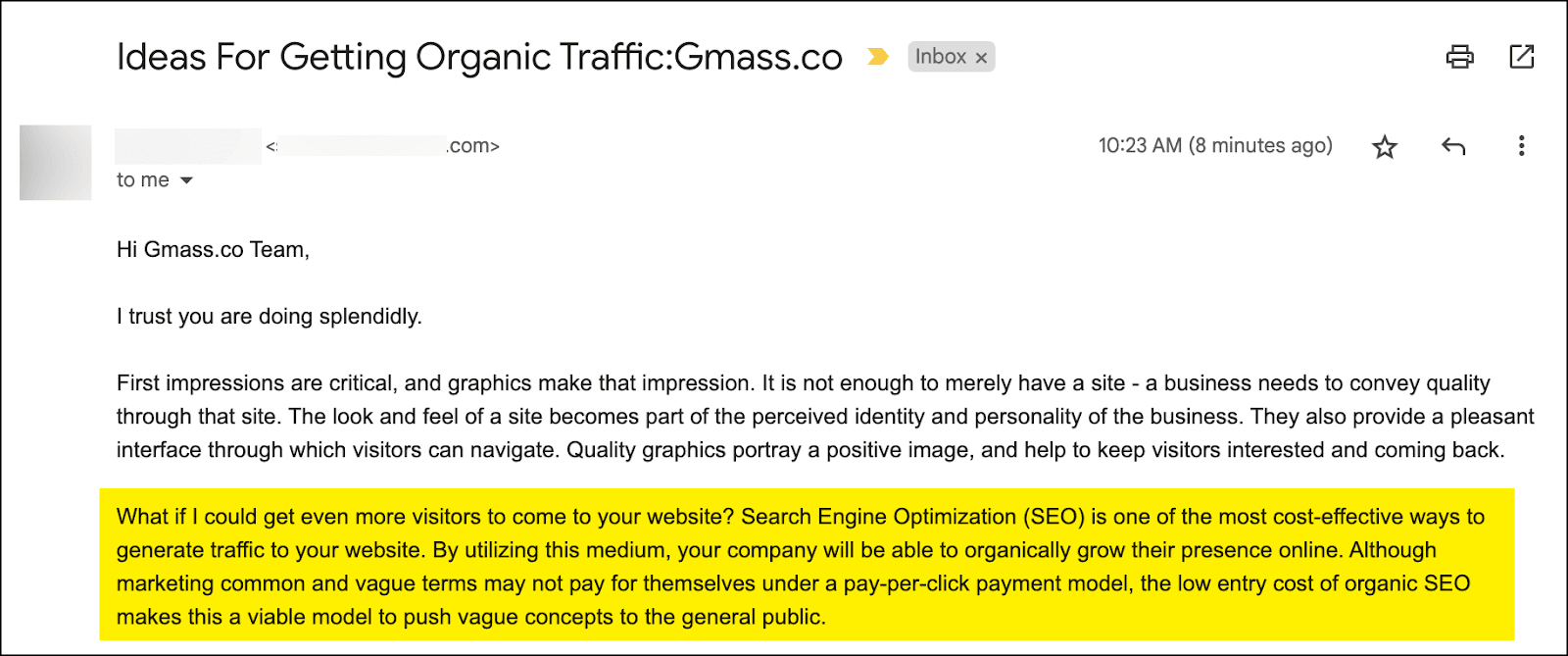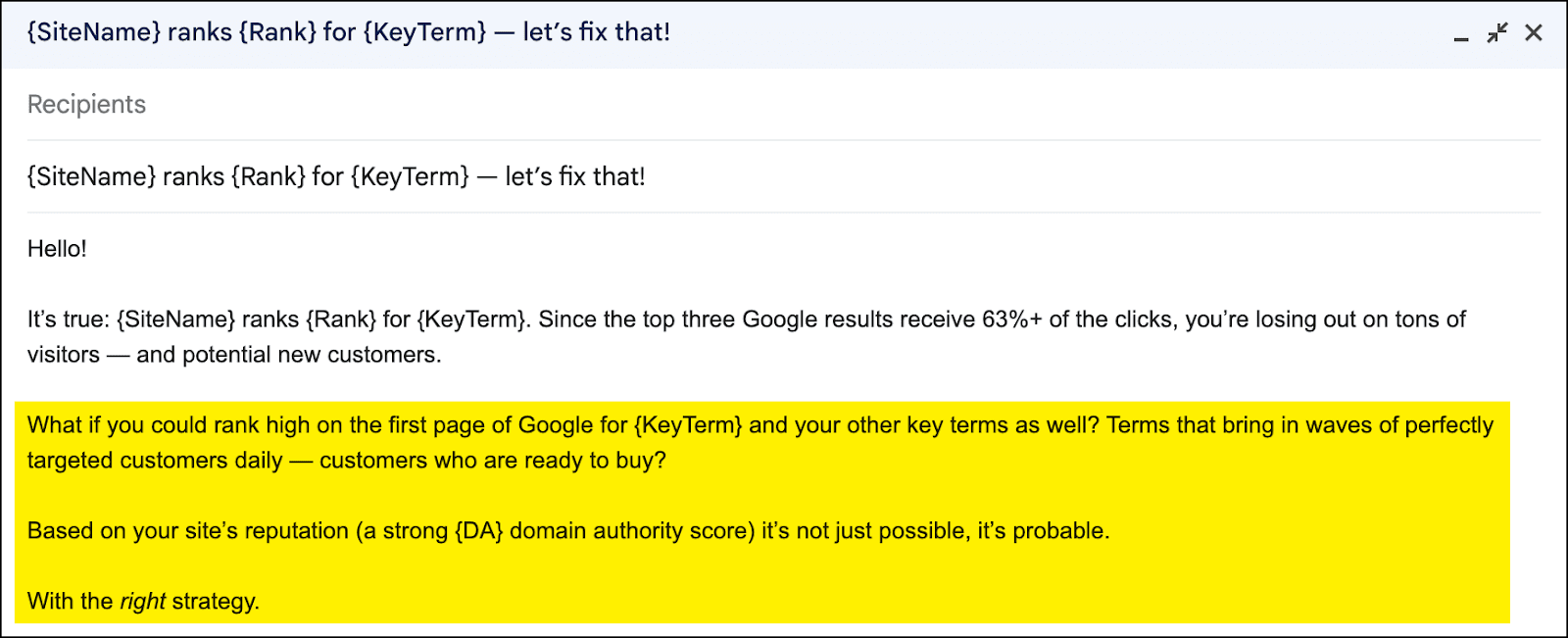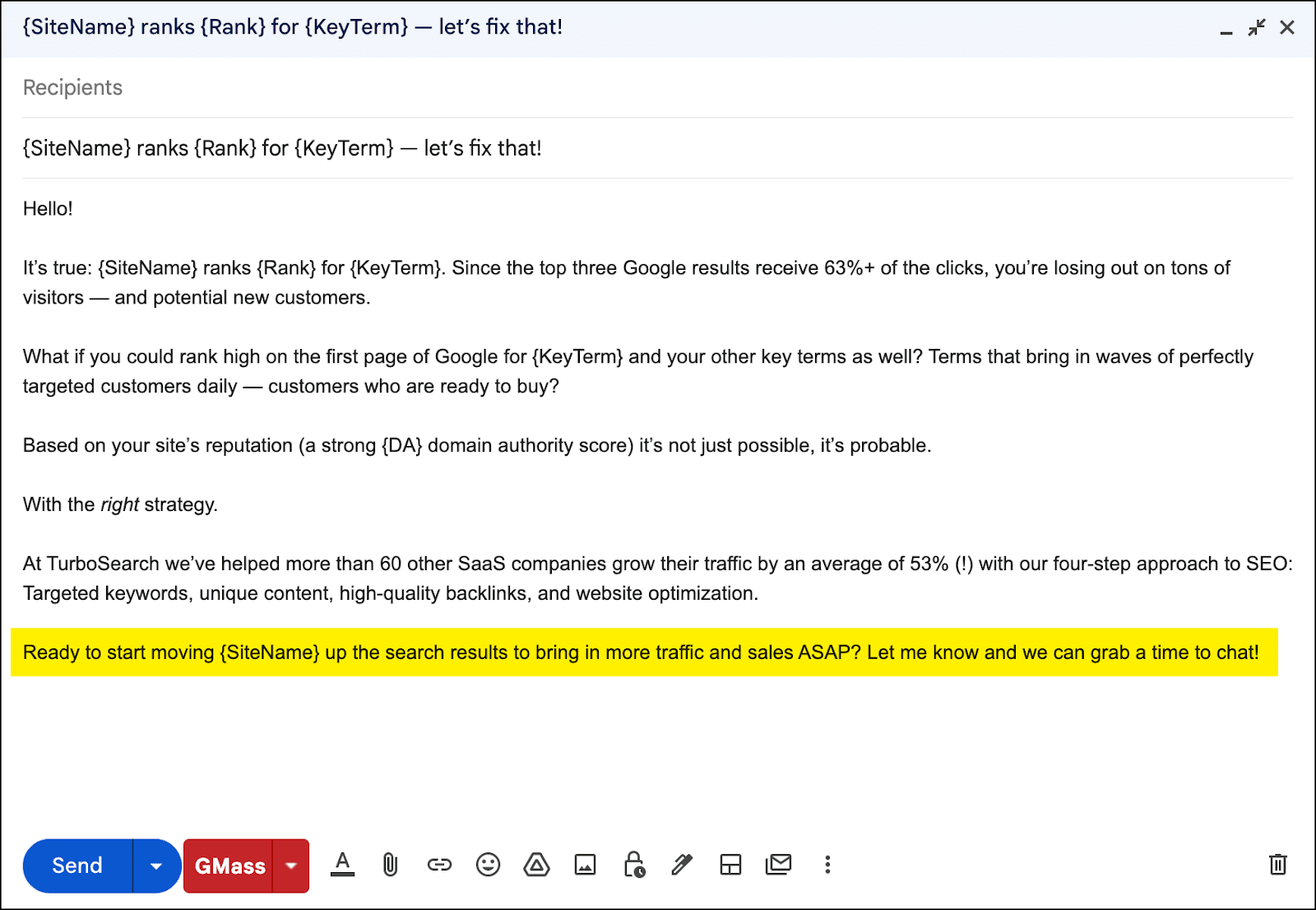
Before After Bridge copywriting (or BAB) is a cold email storytelling model that, when used right, can take your product or service from “unknown” to “must-have.”
And… it can do that in a matter of three sentences or short paragraphs.
BAB differs from the sales funnel-based approach of the AIDA formula or the fear-triggering approach of PAS copywriting.
With Before After Bridge, you’re using aspirational storytelling to give each recipient a tantalizing glimpse of what their future could be.
And, when you execute BAB copywriting correctly, your recipient will believe their best path to that future is to hire you or buy your product.
In this article, I’ll cover each of the three steps of Before After Bridge cold emails and share tips and strategies for getting the most out of each part. I’ll also show examples of the right and wrong way to present each of the steps.
Here’s how to use Before After Bridge without coming off like you’ve got a bridge to sell.
Before After Bridge Copywriting: Table of Contents
- What Is the BAB Copywriting Model?
- 1. Before: Understand Your Recipient’s Bleak Current Reality
- 2. After: Showing Your Prospect Their Utopian Future
- 3. Bridge: How and Why You’re the Right Person to Take Your Prospect From the Before to the After
- 4. Call-to-Action: How to Get a Reply to Your BAB Email
- Before After Bridge Copywriting for Cold Email: Takeaways and Next Steps
What Is the BAB Copywriting Model?
The Before-After-Bridge copywriting model for cold email uses three steps, ideally one sentence each, to take a prospect on a journey from unaware of your product or service to unsure of how they can go on living without it.
The three steps of the BAB model are:
- Before. Recognizing one of your recipient’s current problems, pain points, or needs.
- After. Painting a picture of what your recipient’s life could be like after they remedy that problem/pain/need.
- Bridge. Succinctly explaining why your product or service is the “bridge” from the before to the after.
The BAB model is effective because it uses storytelling (our brains are wired to love stories) to evoke an emotional response.
You make your recipient the star of the story, then show them their happy ending. Now that you’ve planted that seed, you’ve made them want to turn that story into a reality.
From a copywriting perspective, BAB is a useful framework because it keeps you focused on benefits, not features. After all, you’re not going to tell someone: “Now imagine a world where you’re using software that has a database of more than 8 million keywords.” You’d say, “Imagine ranking at the top of Google for all of your most important keywords.”
When is the Before After Bridge model best for cold email?
Before After Bridge copywriting is best when you’re presenting a product or service that generates a positive outcome (not something that avoids a negative outcome, like, say, insurance or cybersecurity).
BAB is good to use when someone likely has never heard of your product or service before — or might not even know a product or service like yours exists.
But, like pretty much every cold email method, BAB isn’t going to work unless you have a solid understanding of each prospect’s pain point — and your product or service is the right solution.
So make sure you’ve researched your prospects, you understand what they want and need, and you’re ready to personalize your messaging around those needs.
Now let’s get into each step of the BAB model and how to do it right.
1. Before: Understand Your Recipient’s Bleak Current Reality
In BAB copywriting, “before” is really the “present.” No, your recipient’s life probably isn’t completely and totally terrible. But there’s something in their business or professional life that’s falling short of their hopes.
You’ve identified what that thing is. And you’re going to put it right there in front of them, painful as it may be, in plain black-and-white. Then you’re going to take on that problem together.
The Before section of the email largely comes down to who you’re targeting (and who needs what you have to offer). If you’ve properly identified your target customers, you’ll have an accurate understanding of their “before” reality.
Are there some Before scenarios that are universal?
There are some common pain points, wants, and needs across most businesses. It’s hard to imagine anyone who wouldn’t want to get more customers, save time, outperform their competitors, get more web traffic, and/or increase their revenue.
But there are remedies that will work for some businesses that won’t work for others.
For example, I get tons of cold emails offering SEO services to get more traffic and drive more business. But I’m good on SEO. I have my own expertise, my own strategy I’m executing — and I’m happy with my performance. Someone who researched would see I’m in a good place on search. It’s not an area of weakness, so it’s not an answer to my Before problems.
So yes, there are universal Before scenarios common across most or all businesses. But not every Bridge is the right way to get that business to the After. Your job during the prospecting process is to find the businesses who do need your Bridge.
Putting together the “Before” section of your email
In this article I’m going to use an example of a real cold email I received from a company selling SEO services. And I’ll compare that email with one that better utilizes Before After Bridge copywriting to make a more effective pitch.
The Before in the original email I received
Subject: Ideas For Getting Organic Traffic:GMass.co
Message: Hi Gmass.co Team,
I trust you are doing splendidly.
First impressions are critical, and graphics make that impression. It’s not enough to merely have a site – a business needs to convey quality through that site. The look and feel of a site becomes part of the perceived identity and personality of the business. They also provide a pleasant interface through which visitors can quickly navigate. Quality graphics portray a positive image, and help to keep visitors interested and coming back.

Alright… so yeah, I picked an egregiously bad cold email as my example for this article. All the better to point out lots and lots of flaws in the process, right?
First off, this email starts rough because they’re selling SEO services… and from this long, long, long paragraph, it seems like they’re selling graphic design.
Even before that…
The subject line
The subject line doesn’t feel like a one-on-one email. Every word is capitalized, like it’s a title. They forgot to add a space after the colon when they put in their mail merge. They got the capitalization wrong on GMass.
Plus, the subject line commits one of the biggest sins of subject lines: It sets incorrect expectations. There are no ideas in this email for getting organic traffic for GMass, just generic SEO buzzwords.
The intro
The “Hi Gmass.co Team” is bad. That greeting feels like mail merge, not something a person typed in a one-on-one message. (And again, they got the capitalization wrong on GMass, where we capitalize the G and the M.)
The throwaway pleasantry of “I trust you are doing splendidly” adds no value and wastes even more words.
What’s wrong with this Before
But back to the “before” concept behind this email. As I said earlier in this article, SEO is not one of my pressing pain points. Yes, every site always wants to do better in search and get more organic traffic, but this isn’t an area of critical concern — which they’d know if they’d done more thorough research.
Even if I did want SEO help, however, this Before section isn’t going to persuade me.
I’m pretty sure by this point in time, everyone knows the point of having a website. But even if I didn’t appreciate the value of a website… this paragraph isn’t hitting on the pain of poor SEO. Not at all.
My rewrite
Here’s my rewrite:
Subject: {SiteName} ranks {Rank} for {KeyTerm} — let’s fix that!
Message: Hello!
It’s true: {SiteName} ranks {Rank} for {KeyTerm}. Since the top three Google results receive 63%+ of the clicks, you’re losing out on tons of visitors — and potential new customers.

What I’ve done here is a little bit of research that’s eye-catching, presents a “before” reality in need of a fix — and should even send a little bit of a painful chill down the recipient’s body.
When this recipient sees my subject line, they’re going to have to open the email to read more. It’s targeted, it’s personalized, and it’s scary.
Then, when they see my Before scenario, I’ve primed them to the point where they’re going to want a remedy now.
Notice I didn’t feel the need to provide multiple keyword examples. Odds are if one key term is struggling, they know they have lots of key terms that are struggling.
I played around with the phrasing on the second sentence and tried: “Since the top three Google results receive 63%+ of the clicks, your competitors are getting all those visitors — and potential customers.” But that felt more generic and spammy to me. If I was going to use that line, I’d want to add another mail merge tag and specifically their competitors who are outranking them.
My email is highly personalized and requires research — but I’m making a little bit of research go a long way. I could find a prospect’s website, figure out an important keyword, and grab their search rank for that keyword in a matter of minutes — maybe even under a minute. Later in this article, I’ll also bring in another bit of personalization when I cite the company’s domain authority; thanks to my Ahrefs toolbar, that adds zero extra time to the research process.
2. After: Showing Your Prospect Their Utopian Future
Now that you’ve reminded your prospect of their major pain point (or, perhaps, introduced them to a brand new pain they weren’t actively thinking about), it’s time to fast forward to the end of the story.
We’ll skip the hero’s journey and get right to the happy ending with the After.
You want the “after” to be realistic but highly optimistic. To present a future that would make your prospect happy and completely fix their problem or pain. And to show a world they have to live in.
Putting together the “After” section of your email
The After in the original email I received
What if I could get even more visitors to come to your website? Search Engine Optimization (SEO) is one of the most cost-effective ways to generate traffic to your website. By utilizing this medium, your company will be able to organically grow their presence online. Although marketing common and vague terms may not pay for themselves under a pay-per-click model, the low entry cost of organic SEO makes this a viable model to push vague concepts to the general public.

What’s wrong with this After
Once again, there’s so much wrong here (the length of the paragraph alone…)
This After begins with classic After phrasing: “What if I could…” They got that part right. In this storytelling style it’s common to present the future as a hypothetical… but one that’s actually attainable.
From there, however, the pitch is all wrong. This paragraph isn’t showing me “after” results.
In fact, it’s mostly a long tangent about ranking for vague terms. If their recipient knows anything — anything at all — about SEO, they wouldn’t care about those vague terms. They’d want to rank for terms that have search intent.
(I personally don’t care if GMass ranks for the vague term “mass.” People looking for physics and/or Catholic services aren’t going to want our product if they come to the site.)
So to devote the majority of the paragraph to the idea of “pushing vague concepts” is not just irrelevant, it’s downright wrong.
There’s nothing about the After world presented here that I want or need to be a part of. Mainly because they forgot to really include me in the After. I can’t picture myself in the world they’ve presented. Much like the terms they want to help me rank for, this After section is nothing but vague concepts.
The After should present benefits, not features. (Or, in this case… neither?)
My rewrite
Here’s how I’d present the After section.
What if you could rank high on the first page of Google for {KeyTerm} and your other key terms as well? Terms that bring in waves of perfectly targeted customers daily — customers who are ready to buy?
Based on your site’s reputation (a strong {DA} domain authority score) it’s not just possible, it’s probable.
With the right strategy.

I focus on benefits and results, not features, in my After section here.
I’m also careful not to use buzzwords or jargon (like “transactional intent”) which might alienate recipients with less of an SEO background — but I give enough of a hint at the concepts that a pro would know I’m coming from a place of expertise.
Notice how I like to space out the After section a bit because it feels more like a story to me that way.
Normally, my goal is to keep a cold email as brief as possible. But here, since I have confidence I’ve hooked the recipient and brought them into the story, I’m willing to go slightly longer than usual to sell my point.
I’m presenting an “after” world that’s careful not to guarantee the moon — but does come close to promising the moon. That keeps my After optimistic but realistic, as I suggested at the beginning of this section.
Once again, I bring the email back to a personalized data point on my recipient. I want them to see I’ve researched them and I’m not just generically promising SEO results — based on their domain authority, I’m saying I believe I can get them better search engine results page placements.
By doing so, I’m keeping the story of the After specifically about them. Then, in my last line, I make sure it’s clear they can’t do it on their own.
Time for me to be the bridge.
3. Bridge: How and Why You’re the Right Person to Take Your Prospect From the Before to the After
You’ve presented the bleak reality and the ideal future. Now it’s time to build the bridge between the two — and to make it clear why you’re the person to build it.
In the Bridge section, you should present your product or service along with your best piece of social proof.
By the time your prospect has finished reading the Bridge they should be ready to hire you, sign up for your demo, or otherwise begin engaging with you on going forward.
You don’t want them to be ready to find someone to fix their pain and take them to the After — even if it’s not you. To continue to relate this back to storytelling, they need to now realize it was you all along. You just had to take off your glasses and let down your hair and, boom, time to go to prom with Freddie Prinze Jr.
Putting together the “Bridge” section of your email
The Bridge in the original email I received
Here’s the bridge from the cold email I received offering me SEO services:
Our Aim is to ensure that your website will continue to increase in its rankings, attract more visitors and make more sales through our website optimization, search engine marketing and promotion services. Our main areas of Services are keyword Research and analytics, meta tags optimization, website optimization, web promotion, link popularity building, PPC campaigns, CPC Management, Directory submission, Link Exchange, SEM, Conversion Tracking and Analysis, SEO Reporting etc. We also provide web-related services to businesses that desire professional quality results.

What’s wrong with this Bridge
Getting past the random capitalization (which is a sign of spam), this Bridge reads like a generic resume.
Every SEO company in the world offers these services (though most would have the good sense not to promote “meta tags optimization,” “directory submission,” and other things all serious content and marketing decision makers know are irrelevant).
There’s no social proof here.
There’s nothing personalized.
There’s nothing that makes me think this is the right company to choose.
There’s nothing for someone to latch on to; it’s almost as if they hope someone who knows nothing about SEO will be impressed by an overwhelming avalanche of buzzwords.
My rewrite
Here’s how I’ll present the Bridge section of my email.
At TurboSearch we’ve helped more than 60 other SaaS companies grow their traffic by an average of 53% (!) with our four-step approach to SEO: Targeted keywords, unique content, high-quality backlinks, and website optimization.

I’m keeping my bridge tight. I lead with social proof: I’ve worked with an impressive number of companies in their industry before and have a killer overall stat to show for it.
Then, in less than one sentence, I tease my company’s approach. I don’t go too deep into the specifics but I demonstrate that I have a plan and a system — one with a focus on uniqueness and quality.
I’ve now demonstrated why I’m the right pick to build the bridge from the Before to After and how I’m going to build that bridge.
All that’s left is the close.
4. Call-to-Action: How to Get a Reply to Your BAB Email
The call-to-action isn’t included in the BAB steps but needs to be a part of any BAB cold email.
Now that you’ve laid out the Before, the After, and the Bridge, you need to give the recipient one specific action to take to move things forward.
Asking for a reply is the most common approach, though some people will provide a scheduling link. (Here’s some advice on using Calendly with GMass to fit a scheduling link into your email sequences and workflow.)
The call-of-action in a BAB email should be a no-brainer — your storytelling should drive your recipient to want to take action.
You can, of course, sprinkle in some urgency or scarcity to better drive immediate action.
Let’s finish out these example emails (the bad and the good) by looking at their calls-to-action.
Putting together the CTA section of your email
The call-to-action in the original email I received
Here’s how the original email I received ended.
If you have any questions or need additional information amended to the proposal, please let us know.

This is a soft CTA, certainly not one pushing someone to commit; this is trying to start a dialogue. Maybe. It’s also presenting a likely scenario where the person won’t write back. After all, if I don’t have questions or need more info… then do I just do nothing?
And, as always, the wording is weird here. This email sure doesn’t feel like a proposal. And “need additional information amended” is something ChatGPT would clean up for a non-native English speaker if they ran their copy through there before sending.
My rewrite
Here’s how I’ve closed out my sales email.
Ready to start moving {SiteName} up the search results to bring in more traffic and sales ASAP? Let me know and we can grab a time to chat!

I threw the website into my call-to-action and brought in elements of the Before (low on the search results) and the After (traffic and sales). I ask them to reply to get the conversation going; once they reply, I’ll begin scheduling with them.
I did not specify how long the “chat” might be. I try to avoid specifying a length; if the person is interested, they won’t mind a longer talk once we’re in it. Plus the word “chat” implies a conversation that’s quicker and more informal, which is the vibe I’m going for.
I also played around with a CTA that adds a sense of urgency and scarcity. That is:
Interested? I’m taking on my new clients for March right now (I only take on 3 clients each month to make sure everyone gets maximum attention). So if you’re interested, let me know ASAP and we can chat.
If you feel like that scarcity is credible and will drive more responses, by all means give it a shot. It could also be something worth A/B testing.
Before After Bridge Copywriting for Cold Email: Takeaways and Next Steps
The Before After Bridge copywriting method can be an extremely valuable cold email framework with a little bit of research, strategic copy, and a proper understanding of your target customers’ wants and needs.
BAB is a useful method to keep you focused on benefits, not features, and to hook potential customers through the psychological power of storytelling and visualization.
To review, the elements of BAB are:
- B for Before. Show you understand your recipient’s pain point by painting a picture of their current struggle.
- A for After. Present the ideal scenario where that pain point is now fixed and the recipient is reaping the benefits.
- B for Bridge. Demonstrate why you and only you are the right person to “build the bridge” from the before to the after, preferably with great social proof.
- Call-to-action. The CTA isn’t part of the acronym, but you need to end with a strong call-to-action that compels the recipient to reply to your email.
And now, I’ll use the BAB copywriting method to explain why GMass is the right cold email platform for you to use to send your Before After Bridge emails.
Are you struggling to get your cold emails into people’s inboxes, not their spam folders — especially with what you’re paying for your cold email platform?
Imagine if you could send your emails with confidence knowing they were headed for the inbox — all while you were saving serious money every month.
GMass is one of, if not the, most popular cold email platforms in the world for a reason — more than 300,000 active users have given us an incredible 4.8 star average across 7,500+ reviews.
- GMass works inside Gmail, making it easy to learn and as easy to use as regular email. (Plus it benefits from sending through Gmail’s ultra reliable, high-reputation servers.)
- 99% of GMass users report the best deliverability they’ve ever had. GMass has a built-in email address validator, the unique Spam Solver tool, and custom tracking domains with SSL — all of which get your messages into the inbox.
- GMass has an unparalleled set of features. Whatever you need, from automated follow-ups to A/B testing to scheduling and throttling, you’ll get it at GMass.
- Plus, you’ll get all of this at a lower cost than any other cold email platform out there.
You can get started on GMass’s free trial with no credit card required — you won’t even have to fill out a form. Just download the Chrome extension and check out our quickstart guide. You’ll be sending your first BAB cold email campaign in a matter of minutes.
Email marketing, cold email, and mail merge all in one tool — that works inside Gmail
TRY GMASS FOR FREE
Download Chrome extension - 30 second install!
No credit card required
